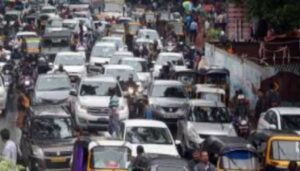Galloping Towards Recovery: Budget 2022

Prof Vilas Adhav and Dr Khalil Shah
When the Finance Minister Mrs Nirmla Seetharaman stood to present the budget expectations in the sections of society and polity were quite divergent. The critics had a free day in doubting every possible tool that would be used for recovery. Therefore, economic recovery was top on the agenda and doubts were raised about the possibility of achieving the 9+ growth rate in the coming year.
Almost all the growth projections across the world projected India’s growth beyond it 8.5% and hence raising doubts about the expectation of growth was quite unreasonable. In the initial statement itself, the Finance Minister placed optimistically but quite rationally the growth to be at 9.2% and expected the crowding in the effect of private investment when public investment increases. She unfolded the four layered vision to reach the Amrit Kal that is the century of India’s independence.
These four priorities include 1. PM Gatishakti; 2. Inclusive Development; 3. Productivity Enhancement & Investment, Sunrise Opportunities, Energy Transition, and Climate Action and 4. Financing investment.
Largely, the growth model that she has outspread involved growth through infrastructure and specifically the PM Gatishakti that goes through seven lanes namely Roads, Railways, Airports, Ports, Mass Transport, Waterways, and Logistics Infrastructure. This strategy is not only to pick up the growth but also to enhance employment in the remote areas of the country. The seven engines of development would not only feel growth through the spillover effect but also create huge employment in all parts of the country.
Therefore, the model elaborated in her budget speech involves achieving multiple goals with a single strategy. Inclusive development also exactly aims at achieving a step up in the growth and income of the components of the society that have stayed on the periphery of development for long. Agriculture forms the stepping stone in the strategy of inclusive development by the Finance Minister. Unusually, not emphasising the rhetoric of technological change and the second Green Revolution which have been used for decades to hoodwink the farmers, the Finance Minister straightaway got to 3 important components namely Small Millets, Natural farming corridor, and Oilseeds.
This is quite a prudent approach along with the promise of Rs 2.37 lakh crores towards MSP and that will be deposited directly in the farmers’ account (very shrewdly eliminating the usual middlemen taking advantage of the farmers). The new Kisan Drone experiment will not only help in crop assessment as well as land records clarifications. A new concept of blended capital to be raised through NABARD will help to build up investment and infrastructure in the agricultural sector.
This is to finance startups for agriculture & rural enterprise, relevant for farm produce value chain. Besides five important river connecting projects and Ken-Betwa remodelling irrigation system has been announced. Agricultural research and extension which are critical components of the development of the agriculture sector have been missing in the entire discussion. In addition to this, the most irritating issue in agriculture is the fragmentation of landholdings both due to demographic pressure and economic inability.
The Finance Minister should have paid attention to the problem of culture falling with 80 million farmers falling under small and marginal farmers groups with a little marketable surplus. FPO is alone will not be sufficient to pull them out of the clutches of local money lenders. The allocation to the agricultural sector increased from Rs 1.48 lakh crores to Rs. 1 .5 lakh crores.
The focus on the industrial sector is largely through MSME that suffered great losses during the lockdown and the pandemic. The losses were both in terms of stoppage of production outmigration of labour and failure of the markets. It was felt necessary to help this sector both through the credit guarantee and with an Accelerating MSME Performance (RAMP) programme with Rs 6,000 crore outlay over 5 years will be rolled out. This outlay comes to Rs. 500 crores per year and that may not be sufficient to bring back on the track the MSMEs.
As expected by many experts the Finance Minister dealt with the education sector elaborate and provided an allocation of Rs 104 thousand crores which were only Rs 88 thousand crores in the previous budget. The education sector includes the PM eVIDYA programme to be covered by 200 channels, Govt schools and vocational courses. Through the digital platforms, it is intended to promote crucial critical thinking and enhance skills through e labs. Infrastructure in the education sector is the main focus. As promised in the manifesto by her government the Finance Minister has taken Ease of Living like Ease of doing business as the focus of her elaboration. Following this philosophy housing, creation of employment, Development initiatives in the North-East, 104 backward district development Vibrant Village Programme, Post Office Banking have been taken in the budget.
In the macro perspective, the Finance Minister had Rs. 22 lakh crore as total revenue it off which Rs 19.3 lakh crore come from tax revenues net to the centre and Rs. 2.69 crore are from the nontax revenue. One can see an almost 9.6 % increase in the tax revenue but a decline of about 44,000 crores in the nontax revenue. Capital receipts have increased to Rs 17.4 lakh crore marking an increase of about 3% or Rs. 50 thousand crores. In total the aggregate receipts in the budget stand at Rs 39.44 crores from the previous Rs 37.70 crores. With this increased room on the revenue side, the Finance Minister had the upper hand in the expenditure.
The effective capital expenditure has been increased this time to Rs. 10.67 crore which is a substantial increase. Capital investment to create jobs as well as growth is the best fork strategy used by the Finance Minister. Even while targeting a growth rate of 9.2% in the coming year the revenue deficit stands at 3.8% of the GDP or about Rs 9.9 lakh crore. The fiscal deficit is pegged at 6.4% of the GDP or Rs. 16.61 crore. On the expenditure side of few important points to be considered here. The expenditure on subsidies of fertiliser food and petroleum have been reduced, has health sector expenditure remained unchanged from the last budget but there is a significant increase in the interest payment from Rs 8.1 lakh crores to Rs 9.4 lakh crore. Interestingly, the GST compensation fund transfers to the States have been Rs 120 thousand crores and other transfers to the State have been put at Rs 334 thousand crores marking an increase of about 17% over last year.
The take-home from this budget is quite interesting and perceptive. First, the Finance Minister has focused entirely on the recovery mode of the economy and thus followed a three-pronged strategy. This included enhancement of capital expenditure which will be directed largely towards infrastructure development and especially the seven engines of growth that she has elaborated. Second, this entangles the employment generation along with it and promises about three and a half crore jobs during the coming years. Third, the inclusivity across the sectors and especially the sectors which suffered during the pandemic have received good support to pick up and participate in the growth efforts of the economy.
At the same time, the Finance Minister also kept inclusivity and spread of growth across the sectors in mind therefore, the quotation from Shanti Parwa applies to the methodology of this budget but then that is the duty of the Finance Minister as well as the Prime Minister of any democratically elected government.








